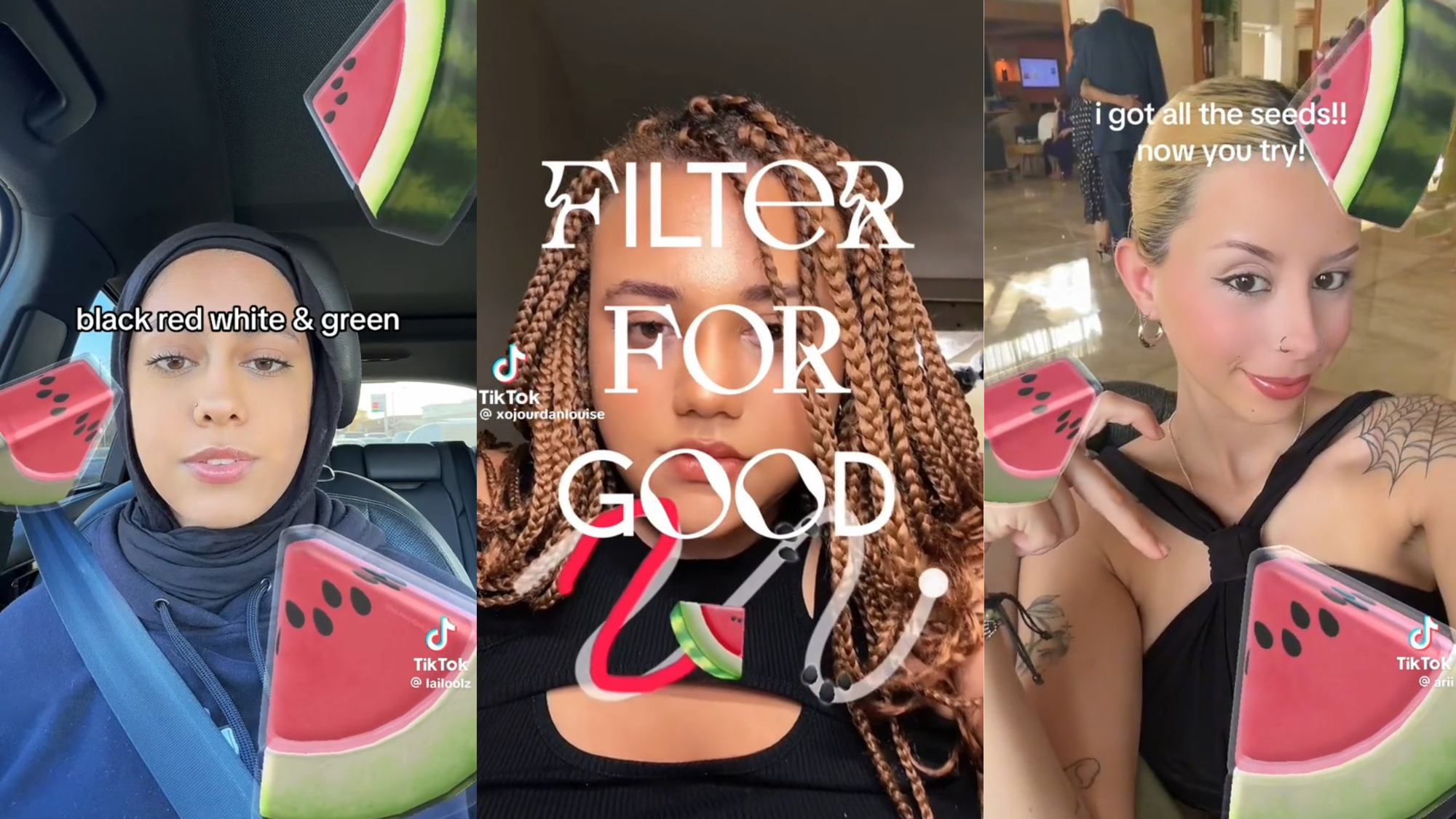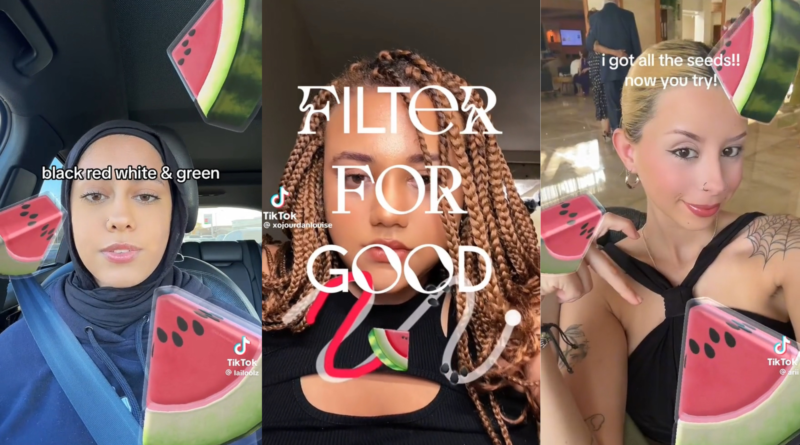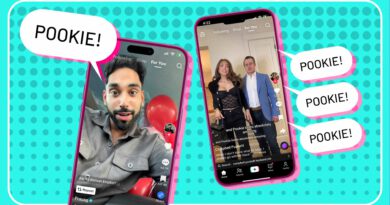How TikTok’s ‘Filter for Good’ is raising money for Palestine

Scrolling endlessly, you stop on one of many TikTok videos. A finger traces across the phone screen, moving a small triangular watermelon slice along a snaking gray line. The person controlling the fruit is meticulously collecting seeds, and when the watermelon envelopes the last cluster of black dots, the screen erupts into large bubbled watermelon slices floating around their head.
Throughout the length of the video, audio from an emotional, stripped down performance of Lorde’s 2013 song “Team,” performed by Palestinian-Canadian artist Nemahsis, plays.
The watermelon game is one of many viral AR filters that make up a crucial segment of TikTok’s interactivity, ingrained in user behavior and app culture. Counter to the often silly face-swapping or AI filters that cross FYPs, however, it represents a burgeoning new use for the app: the free and “no risk” filter is a call to action, attempting to turn creator economies into avenues for social justice.
What exactly is the watermelon filter?
The mind behind the interactive TikTok “game” — which, much like familiar childhood mazes, simply asks users to follow a path to collect objects — is AR effects designer Jourdan Johnson (@XoJourdanLouise). The “Filter for Good,” as she describes in more detail on her page, is not a filter for fun (she’s designed plenty of those), but instead a simple extended reality (XR) experience intended to gather monetary support for the ongoing humanitarian crisis in Palestine.
Her filter coincides with a sustained wave of app attention for the crises, as the bombardment of Gaza continues.
Over the last month, TikTok has become a hub of information for onlookers, activists, and even citizen journalists navigating a complicated media landscape. Young organizers and allies for the Palestinian cause have dominated trending hashtags and content pages, even prompting the company to issue a formal explanation for the overwhelming numbers. “Support for Israel (as compared to sympathy for Palestine) has been lower among younger Americans for some time. This is evidenced by looking at Gallup polling data of millennials dating as far back as 2010, long before TikTok even existed,” the company explained, pointing to more established (and thus frequented) pro-Palestinian hashtags and historic Pew Research data to explain why its algorithms might feel “skewed” toward one type of posting. “The data shows that this support is not new and was rising before TikTok was created, so it would be unrealistic to ascribe such broad sentiments to a single communications channel such as TikTok.”
As well, across social media and even generative AI platforms, users have deciphered ways to work around banned and suppressed content, disinformation, and algorithmic ranking to share important information.
Johnson introduced the filter in a video posted to her TikTok page on Nov. 6, with the caption:
USE THIS FILTER 🍉 to help the people of Gaza. As an AR creator, I am part of the Effect Creator Rewards program – basically like the creativity fund but for effect creators. This allows me to earn money for each unique video published using my effects. I have created this FILTER FOR GOOD effect and will be donating the rewards earned to charities providing aid in Gaza. I know many of us don’t know how to help, but it can be as simple as posting a video with this filter!
The filter’s watermelon slices allude to a longstanding Palestinian resistance and solidarity symbol used to sidestep censorship of the Palestinian flag. Mirroring the internet’s quick pick-up of the watermelon imagery and subsequent use of the emoji online to get show support of Palestinians, Johnson told Mashable that the filter’s inspiration came from seeing other creators and activists speaking out online, although she was the first to go the route of AR.
“For the last few weeks, like many people, I have been following what has been happening and finding ways to show support,” Johnsons said. “The day before I published the filter, I had come across a TikTok creator who made a video explaining that they were a part of the Creativity Program Beta and would be donating the earnings from that video. I saw that and was inspired — I was a part of the Effect Creator Rewards program and had the potential to earn money from a filter, so I could do a similar thing. So on Nov. 6, I created the effect, submitted, and by the late afternoon it was published and active.”
Users quickly flocked to her filter, which garnered a whopping 6.2 million uses by Nov. 15, including videos from major app influencers and celebrities.
Johnson has pledged to send her payout from people using the filter to humanitarian aid organizations (like Doctors Without Borders, the Palestine Children’s Relief Fund, and Human Appeal), and — in her initial posts — community efforts to purchase and distribute eSim cards, although those decisions are evolving.
How does the “Filter for Good” generate humanitarian aid?
Despite the extremely low barrier to entry for those looking to help, the filter’s ability to collect money is a bit complicated: Funds generated from the filter’s use aren’t on an automatic, dollar-per-view payout system like some might assume. As Johnson described in the initial post, the payout is dependent on TikTok’s creator-side monetization system, which includes the relatively new Effect Creator Rewards program.
The effects payout program allows recognized creators — users who have at least 5 effects published on the app and 3 effects used in 1,000 videos each — to claim their viral TikTok effects, including getting direct payments for their use and paid promotion opportunities. Program members are “ranked” on a tiered system, marked by badges that denote the number of effects and uses they’ve gained since they joined.
Johnson, a platinum badge earner and an “Effect House Top Creator,” explained in her initial video that qualified effects won’t begin gathering rewards until they’ve gained 200,000 “qualified publishes” in a 90-day period. According to TikTok’s FAQ, qualified video publishes are unique daily TikTok videos from eligible regions — they can be posted on both public and private accounts, but can’t remain in a user’s drafts. For example, the company explains, if a user publishes two different videos using the same effect on the same day, this counts as one qualified video publish.
Effect creators then generate money based on every 1,000 publishes (known as Revenue Per Mille), with the total amount capped by regional limits. The maximum payment a single effect can collect is $ 14,000. A creator’s monthly maximum payment won’t exceed $ 50,000.
There’s one last hurdle: Effect creators rewards are paid out on a biweekly schedule, meaning the previous month’s earnings are distributed to a creator’s account on the 15th of every month.
Johnson has posted a daily update on the Filter for Good’s earnings since it reached 200,000 qualified views, including additional context on the Effect Creator Rewards system. In a Nov. 15 update, she explained the filter had gathered 4.5 million qualified publishes (of a total 6.3 million uses) and generated $ 12,442 so far. Earnings from October should be paid out on Nov. 15 (today), while all of November’s earnings will be distributed on Dec. 15.
Is the “Filter for Good” actually helping?
Not long after Johnson’s publishing, other TikTok creators released their own “filters for good,” including those supporting Israeli-led humanitarian efforts, with similar claims of using creator rewards to support charities on the ground.
The rush of filters and watermelon games worried some online, harkening back to the onslaught of black boxes posted to Instagram profiles in support of the Black Lives Matter movement, known as “Blackout Tuesday,” which symbolized for many a misplaced display of allyship that overpowered crucial information spread by organizers. Some claimed the overwhelming amount of watermelon game filters, including the Filter for Good, was obscuring videos sharing breaking news and educational content.
Many also pointed out that Palestinians and human rights organizations have reported blocked aid sitting at the borders, with no way of distributing aid that’s already been sent to the region. In addition to concerns about verifying Johnson and her commitment to donating, these users wondered if the money would even matter.
Johnson explained both on her TikTok page and to Mashable that she is aware of the concerns, warning people of copycat creators and providing ways to vet both her and other creators. She also said she’s in direct contact with aid workers and medical professionals on the ground in Gaza, who are helping her decide where exactly to send the money once it’s available.
“I’ve researched organizations to donate the funds to those that have people on the ground, as well as what the people are requesting, like eSims,” she says. “Since last week, eSims have no longer become the priority, so in addition to the aid organizations, I believe that it’ll be more efficient to determine where the rest of the funds will go when they are available, in order to prioritize what is needed at that time.”
While those thousands of potential dollars wait to be distributed – and millions of eyes train themselves on her page — Johnson also sees continued potential in the filter’s ability to share information and act as a starting point for mass education.
“I think the simplicity of this filter makes it easy for it to be incorporated in creative ways. I’ve seen people use it simply as an overlay on their video as they are giving updates; I’ve seen people completing the first drawing part as they are talking about how you can call your representatives — the content doesn’t need to be solely about the effect,” Johnson explained. In fact, she says in a Nov. 12 update that she doesn’t want people to use the trending filter to game the algorithm using typical means, with trending audios, clickbait captions, or misleading hashtags.
In her Nov.14 update, Johnson included additional ways to support the cause in non-material ways:
1.) Amplify 🍉 voices! Engage with and repost videos that are sharing information/updates on what is happening.
2.) Call your reps and sign petitions! Use resources like the app 5Calls or tinyurl.com/hlscallsreps which will identify your representatives and provide you with a script.
3.) Boycott! Your money is powerful. Learn about the brands you love and what they are doing during this time, and make your buying decisions accordingly.
“I encouraged people to make informative videos because I think it’s important that we don’t lose sight of why this filter was created and what is happening,” Johnson says. “This is just one accessible way people can show support, but it’s important to know that this isn’t the only way.”
The Filter for Good is an inventive social media use case, maybe even a hint at the future potential of hyper-online generations and their ability to finesse the tools and algorithms pushed onto them by tech and media corporations. The filter’s accessibility is also appealing for those without the financial ability to donate to causes they support or who don’t know how to get involved.
“With these social platforms, we are able to reach so many people, and so many people across the world so quickly. I think it will only enhance communication, raise awareness, and allow people to mobilize in more ways,” she says.
But there’s a fear, as even Johnson communicates, that the low-lift social media-based fundraising opportunity is where supporters will stop — and that the many avenues for misuse will erase the technology’s potential for good.

